The Impact of Land Use on Peat Characteristics in the Highlands of Humbang Hasundutan, Indonesia
Abstract
1. Introduction
2. Materials and Methods
3. Results
3.1. Distribution Patterns of C, N, pH, and Soil Respiration
3.2. The Influence of Area, Land Use, and Their Interaction on Soil Parameters
3.3. Principal Component Analysis (PCA) of Peat Soil Quality Parameters
4. Discussion
5. Conclusions
Author Contributions
Funding
Data Availability Statement
Conflicts of Interest
References
- Omar, M.S.; Ifandi, E.; Sukri, R.S.; Kalaitzidis, S.; Christanis, K.; Lai, D.T.C.; Bashir, S.; Tsikouras, B. Peatlands in Southeast Asia: A Comprehensive Geological Review. Earth-Sci. Rev. 2022, 232, 104149. [Google Scholar] [CrossRef]
- Leifeld, J.; Menichetti, L. The Underappreciated Potential of Peatlands in Global Climate Change Mitigation Strategies. Nat. Commun. 2018, 9, 1071. [Google Scholar] [CrossRef]
- Minasny, B.; Adetsu, D.V.; Aitkenhead, M.; Artz, R.R.E.; Baggaley, N.; Barthelmes, A.; Beucher, A.; Caron, J.; Conchedda, G.; Connolly, J.; et al. Mapping and Monitoring Peatland Conditions from Global to Field Scale. Biogeochemistry 2024, 167, 383–425. [Google Scholar] [CrossRef]
- Anda, M.; Ritung, S.; Suryani, E.; Sukarman; Hikmat, M.; Yatno, E.; Mulyani, A.; Subandiono, R.E.; Suratman; Husnain. Revisiting Tropical Peatlands in Indonesia: Semi-Detailed Mapping, Extent and Depth Distribution Assessment. Geoderma 2021, 402, 115235. [Google Scholar] [CrossRef]
- Pacheco-Cancino, P.A.; Carrillo-López, R.F.; Sepulveda-Jauregui, A.; Somos-Valenzuela, M.A. Sphagnum Mosses, the Impact of Disturbances and Anthropogenic Management Actions on Their Ecological Role in CO2 Fluxes Generated in Peatland Ecosystems. Glob. Chang. Biol. 2024, 30, e16972. [Google Scholar] [CrossRef] [PubMed]
- Laiho, R. Decomposition in Peatlands: Reconciling Seemingly Contrasting Results on the Impacts of Lowered Water Levels. Soil Biol. Biochem. 2006, 38, 2011–2024. [Google Scholar] [CrossRef]
- Munawaroh, H.; Rauf, A.; Razali; Bintang; Sabrina, T. Preliminary Study on C-Organic and C-Microbial Biomass of Peatland in Toba Highlands. IOP Conf. Ser. Earth Environ. Sci. 2022, 1025, 012017. [Google Scholar] [CrossRef]
- Gaffney, P.P.J.; Tang, Q.; Wang, J.; Zhang, C.; Xu, X.; Xu, X.; Li, Y.; Pap, S.; Ratcliffe, J.L.; Li, Q.; et al. The High-Altitude Peatland Carbon Cycle: A Review of the Impacts of Climate and Land-Use Change. Geogr. Sustain. 2025, 6, 100353. [Google Scholar] [CrossRef]
- Polak, E. Ueber Torf Und Moor in Niederländisch Indien; North-Holland Publishing Company: Amsterdam, The Netherlands, 1933; Volume 30, Available online: https://cir.nii.ac.jp/crid/1971430859825830460.
- Maloney, B.K. Pollen Analytical Evidence for Early Forest Clearance in North Sumatra. Nature 1980, 287, 324–326. [Google Scholar] [CrossRef]
- Minasny, B.; Sabrina, T.; Akoeb, E.N. Toba Highland Peatlands: Exploring a Unique Ecosystem and Its Environmental Significance. J. Smart Agric. Environ. Technol. 2023, 1, 66–72. [Google Scholar] [CrossRef]
- Sinurat, P.T.; Munibah, K.; Baskoro, D.P.T. Modeling Land-Use Change in Humbang Hasundutan District Using Clue-S. J. Ilmu Tanah Dan Lingkung. 2015, 17, 75–82. [Google Scholar] [CrossRef]
- Taufik, M.; Minasny, B.; Mcbratney, A.B.; Van Dam, J.C.; Jones, P.D.; Van Lanen, H.A.J. Human-Induced Changes in Indonesian Peatlands Increase Drought Severity. Environ. Res. Lett. 2020, 15, 084013. [Google Scholar] [CrossRef]
- Murdiyarso, D.; Lilleskov, E.; Kolka, R. Tropical Peatlands under Siege: The Need for Evidence-Based Policies and Strategies. Mitig. Adapt. Strateg. Glob. Chang. 2019, 24, 493–505. [Google Scholar] [CrossRef]
- Fiantis, D.; Rudiyanto; Ginting, F.I.; Agtalarik, A.; Arianto, D.T.; Wichaksono, P.; Irfan, R.; Nelson, M.; Gusnidar, G.; Jeon, S.; et al. Mapping Peat Thickness and Carbon Stock of a Degraded Peatland in West Sumatra, Indonesia. Soil Use Manag. 2024, 40, e12954. [Google Scholar] [CrossRef]
- Qin, L.; Freeman, C.; Jia, X.; Zhang, Z.; Liu, B.; Zhang, S.; Jiang, M. Microbial Enzyme Activity and Stoichiometry Signal the Effects of Agricultural Intervention on Nutrient Cycling in Peatlands. Ecol. Indic. 2021, 122, 107242. [Google Scholar] [CrossRef]
- Savichev, O.; Soldatova, E.; Rudmin, M.; Mazurov, A. Geochemical Barriers in Oligotrophic Peat Bog (Western Siberia). Appl. Geochem. 2020, 113, 104519. [Google Scholar] [CrossRef]
- Widati, S. Soil Biology Analysis Methods; Center for Agricultural Land Resources Research and Development: Bogor, Indonesia, 2007. [Google Scholar]
- Don, A.; Schumacher, J.; Freibauer, A. Impact of Tropical Land-use Change on Soil Organic Carbon Stocks—A Meta-analysis. Glob. Chang. Biol. 2011, 17, 1658–1670. [Google Scholar] [CrossRef]
- Guo, L.B.; Gifford, R.M. Soil Carbon Stocks and Land Use Change: A Meta Analysis. Glob. Chang. Biol. 2002, 8, 345–360. [Google Scholar] [CrossRef]
- Raich, J.W.; Schlesinger, W.H. The Global Carbon Dioxide Flux in Soil Respiration and Its Relationship to Vegetation and Climate. Tellus B Chem. Phys. Meteorol. 1992, 44, 81–99. [Google Scholar] [CrossRef]
- Wardle, D.A. Communities and Ecosystems: Linking the Aboveground and Belowground Components (MPB-34); Princeton University Press: Princeton, NJ, USA, 2013. [Google Scholar]
- Hättenschwiler, S.; Vitousek, P.M. The Role of Polyphenols in Terrestrial Ecosystem Nutrient Cycling. Trends Ecol. Evol. 2000, 15, 238–243. [Google Scholar] [CrossRef] [PubMed]
- Berg, B.; McClaugherty, C. Plant Litter: Decomposition, Humus Formation, Carbon Sequestration; Springer: Berlin/Heidelberg, Germany, 2008. [Google Scholar]
- Fang, C.; Moncrieff, J.B. The Variation of Soil Microbial Respiration with Depth in Relation to Soil Carbon Composition. Plant Soil 2005, 268, 243–253. [Google Scholar] [CrossRef]
- Henry, W. Experiments on the Quantity of Gases Absorbed by Water, at Different Temperatures, and under Different Pressures. Philos. Trans. R. Soc. Lond. 1802, 93, 29–274. [Google Scholar]
- de Paula, J. Atkins’ Physical Chemistry; Oxford University Press: Oxford, UK, 2010. [Google Scholar]
- Hergoualc’h, K.; Verchot, L.V. Stocks and Fluxes of Carbon Associated with Land Use Change in Southeast Asian Tropical Peatlands: A Review. Glob. Biogeochem. Cycles 2011, 25, GB2001. [Google Scholar] [CrossRef]
- Maloney, B.K.; McCormac, F.G. Palaeoenvironments of North Sumatra: A 30,000 Year Old Pollen Record from Pea Bullok. Bull. Indo-Pac. Prehistory Assoc. 1996, 14, 73–82. [Google Scholar] [CrossRef]
- Maloney, B.K. Man’s Impact on the Rainforests of West Malesia: The Palynological Record. J. Biogeogr. 1985, 12, 537–558. [Google Scholar] [CrossRef]
- Ruwaimana, M.; Anshari, G.Z.; Silva, L.C.R.; Gavin, D.G. The Oldest Extant Tropical Peatland in the World: A Major Carbon Reservoir for at Least 47 000 Years. Environ. Res. Lett. 2020, 15, 114027. [Google Scholar] [CrossRef]
- Watmough, S.; Gilbert-Parkes, S.; Basiliko, N.; Lamit, L.J.; Lilleskov, E.A.; Andersen, R.; del Aguila-Pasquel, J.; Artz, R.E.; Benscoter, B.W.; Borken, W.; et al. Variation in Carbon and Nitrogen Concentrations among Peatland Categories at the Global Scale. PLoS ONE 2022, 17, e0275149. [Google Scholar] [CrossRef]
- Loisel, J.; Yu, Z.; Beilman, D.W.; Camill, P.; Alm, J.; Amesbury, M.J.; Anderson, D.; Andersson, S.; Bochicchio, C.; Barber, K.; et al. A Database and Synthesis of Northern Peatland Soil Properties and Holocene Carbon and Nitrogen Accumulation. Holocene 2014, 24, 1028–1042. [Google Scholar] [CrossRef]
- Lauber, C.L.; Strickland, M.S.; Bradford, M.A.; Fierer, N. The Influence of Soil Properties on the Structure of Bacterial and Fungal Communities across Land-Use Types. Soil Biol. Biochem. 2008, 40, 2407–2415. [Google Scholar] [CrossRef]
- Cleveland, C.C.; Liptzin, D. C:N:P Stoichiometry in Soil: Is There a “Redfield Ratio” for the Microbial Biomass? Biogeochemistry 2007, 85, 235–252. [Google Scholar] [CrossRef]
- Jangid, K.; Williams, M.A.; Franzluebbers, A.J.; Schmidt, T.M.; Coleman, D.C.; Whitman, W.B. Land-Use History Has a Stronger Impact on Soil Microbial Community Composition than Aboveground Vegetation and Soil Properties. Soil Biol. Biochem. 2011, 43, 2184–2193. [Google Scholar] [CrossRef]
- Saleilei, A.A.; Salampak; Yulianti, N.; Adji, F.F.; Damanik, Z.; Giyanto. Study of C-Organic Content, Ash Content, and Bulk Density of Inland Peat in the Special Purpose Forest Area Tumbang Nusa, Central Kalimantan. J. Environ. Sci. 2022, 16, 59–66. [Google Scholar] [CrossRef]
- Rudiyanto; Minasny, B.; Setiawan, B.I. Further Results on Comparison of Methods for Quantifying Soil Carbon in Tropical Peats. Geoderma 2016, 269, 108–111. [Google Scholar] [CrossRef]
- Lal, R. Soil Carbon Sequestration to Mitigate Climate Change. Geoderma 2004, 123, 1–22. [Google Scholar] [CrossRef]
- Robinson, C.H.; Ritson, J.P.; Alderson, D.M.; Malik, A.A.; Griffiths, R.I.; Heinemeyer, A.; Gallego-Sala, A.V.; Quillet, A.; Robroek, B.J.M.; Evans, C.; et al. Aspects of Microbial Communities in Peatland Carbon Cycling under Changing Climate and Land Use Pressures. Mires Peat 2023, 29, 2. [Google Scholar]
- Yin, T.; Feng, M.; Qiu, C.; Peng, S. Biological Nitrogen Fixation and Nitrogen Accumulation in Peatlands. Front. Earth Sci. 2022, 10, 670867. [Google Scholar] [CrossRef]
- Sinclair, A.L.; Graham, L.L.; Putra, E.I.; Saharjo, B.H.; Applegate, G.; Grover, S.P.; Cochrane, M.A. Effects of Distance from Canal and Degradation History on Peat Bulk Density in a Degraded Tropical Peatland. Sci. Total Environ. 2020, 699, 134199. [Google Scholar] [CrossRef]
- Taufik, M.; Haikal, M.; Widyastuti, M.T.; Arif, C.; Santikayasa, I.P. The Impact of Rewetting Peatland on Fire Hazard in Riau, Indonesia. Sustainability 2023, 15, 2169. [Google Scholar] [CrossRef]
- Zahro, Q.; Izumi, Y.; Novresiandi, D.A.; Cahyana, D.; Widodo, J.; Ito, D.; Ota, K.; Dong, M. Tropical Peatland Restoration Evaluation Using Time-Series L-Band InSAR Analysis. Sci. Rep. 2025, 15, 23749. [Google Scholar] [CrossRef]
- Flood, K.; Wilson, D.; Renou-Wilson, F. Evidence Synthesis and Knowledge Integration for Sustainable Peatland Management. Land 2025, 14, 1397. [Google Scholar] [CrossRef]
- Sarifuddin; Sitohang, E.J.; Mukhlis. Characteristics and Classification of the Peat at Toba Highland, North Sumatera, Indonesia. Ilmu Pertan. Agric. Sci. 2024, 9, 35–42. [Google Scholar] [CrossRef]
- Murdiyarso, D.; Swails, E.; Hergoualc’h, K.; Bhomia, R.; Sasmito, S.D. Refining Greenhouse Gas Emission Factors for Indonesian Peatlands and Mangroves to Meet Ambitious Climate Targets. Proc. Natl. Acad. Sci. USA 2024, 121, e2307219121. [Google Scholar] [CrossRef] [PubMed]
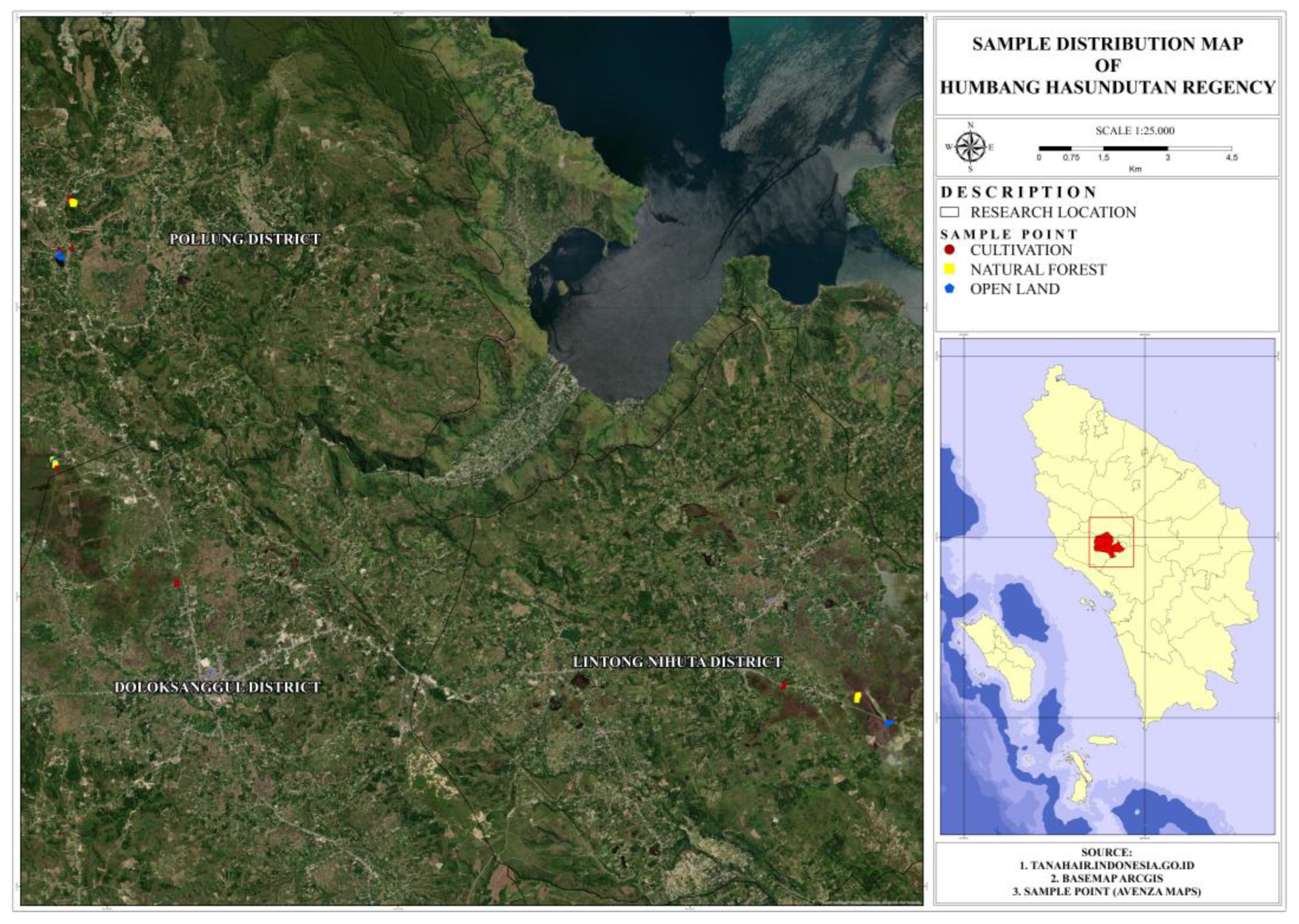
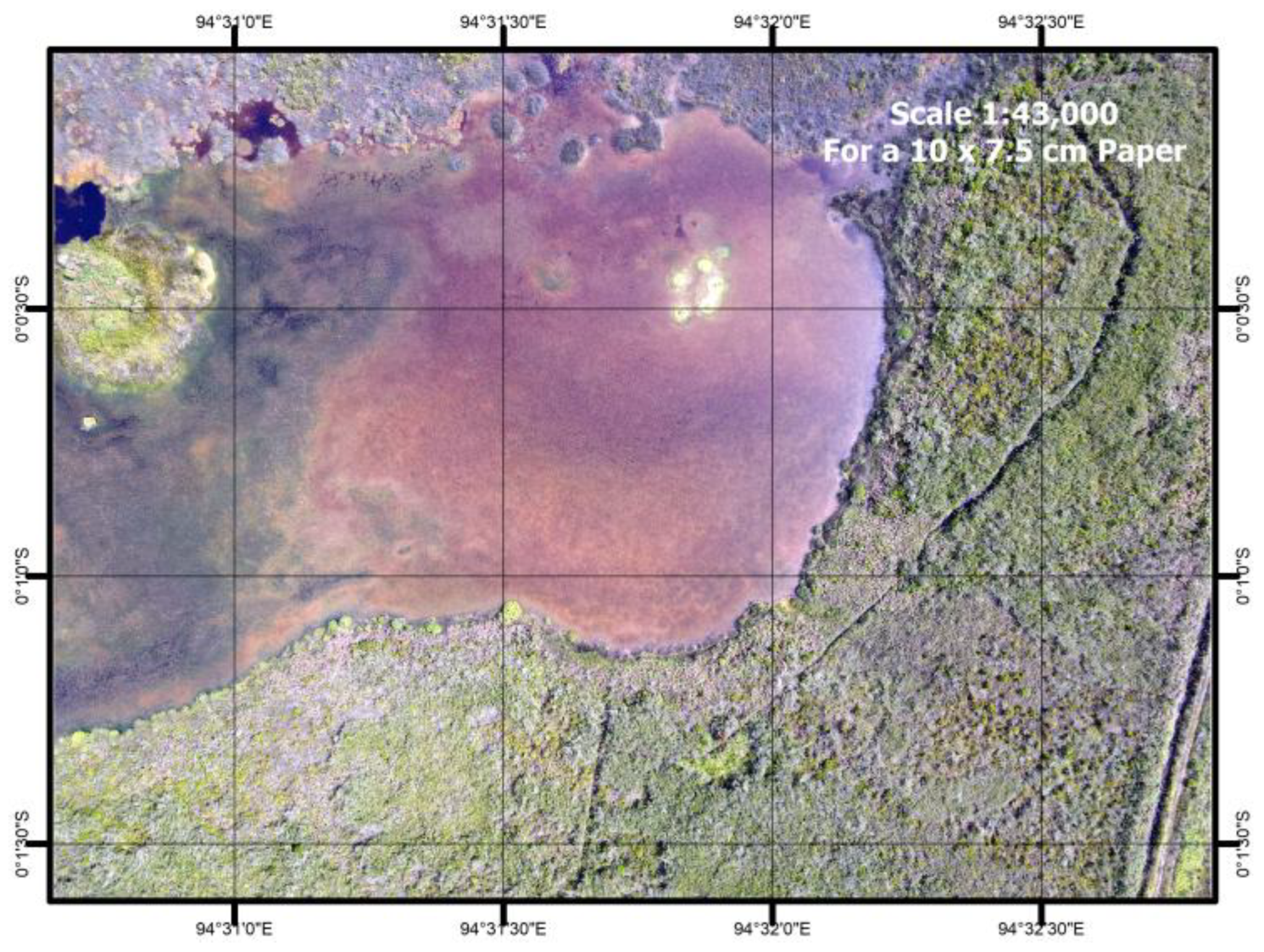
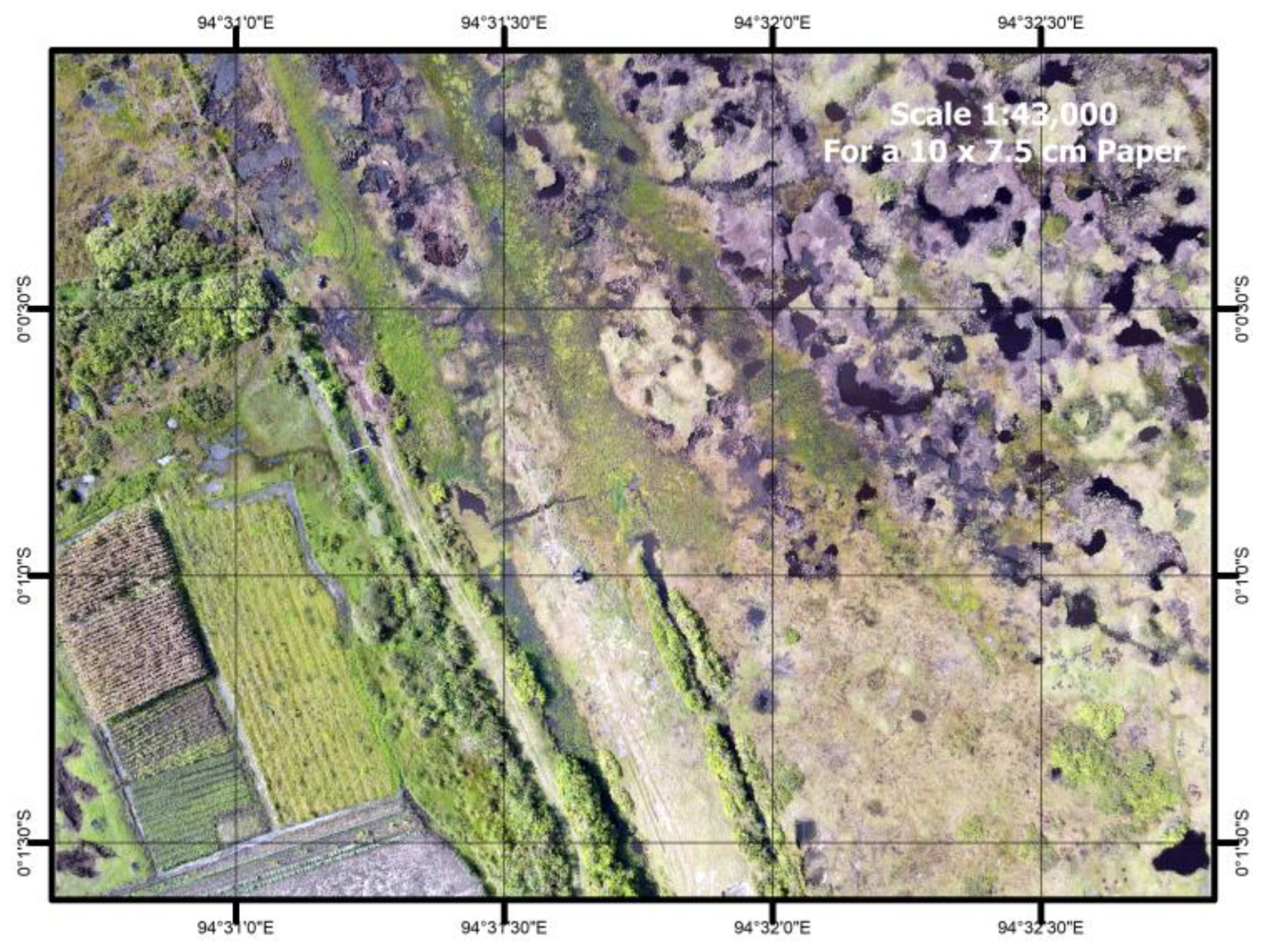

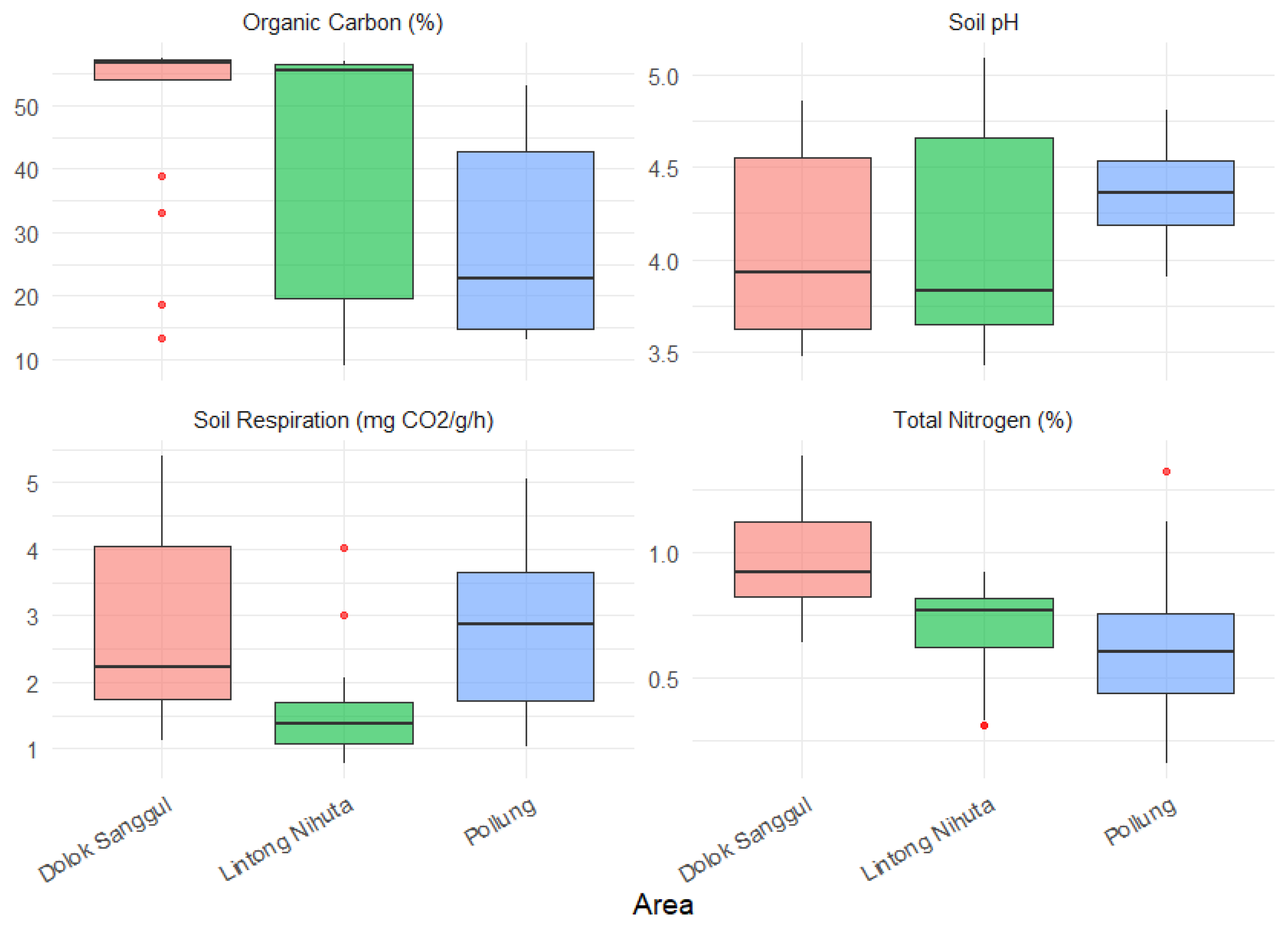
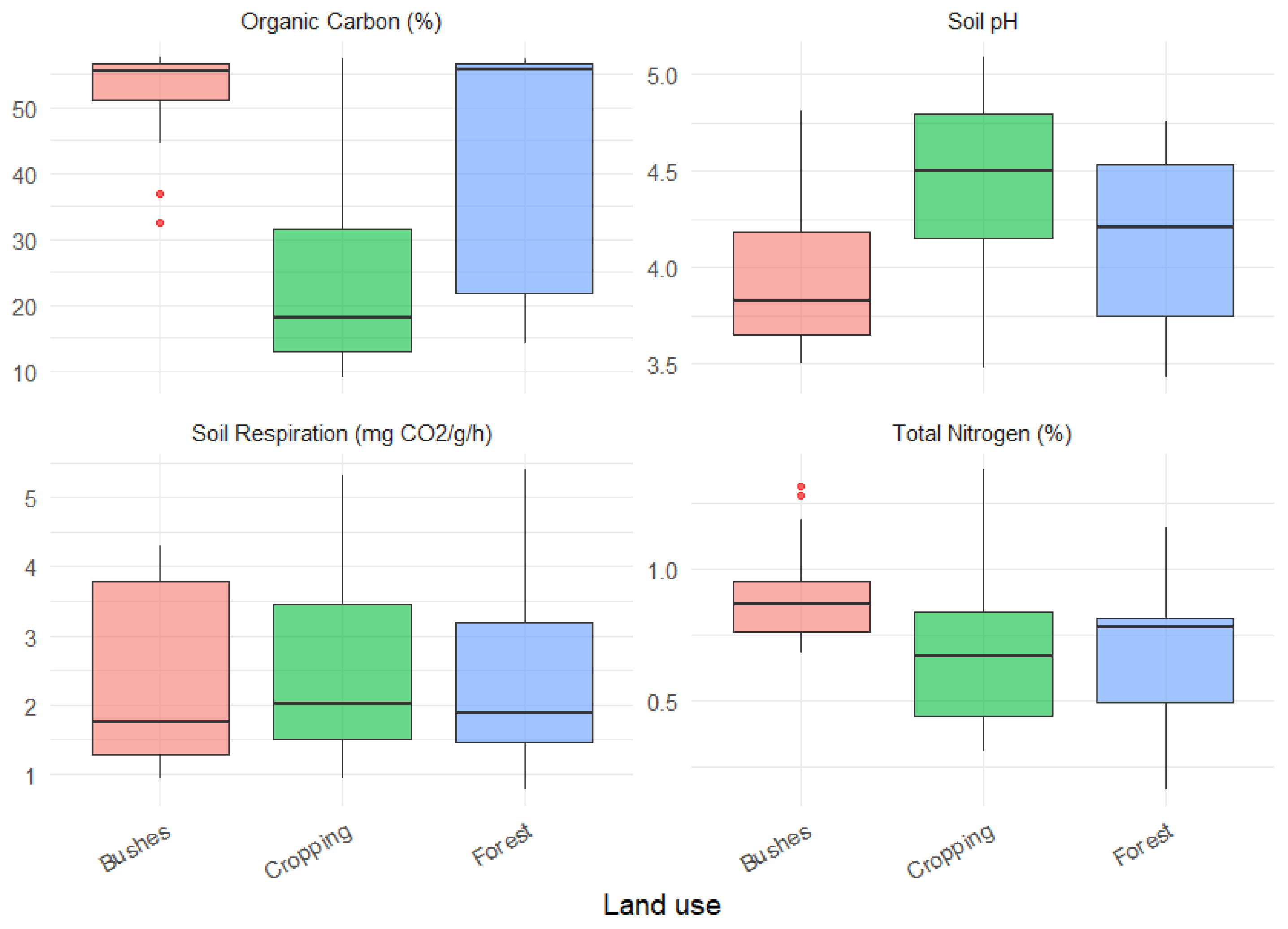

| No. | Location (Sub-District) | Depth | Coordinate (X, Y) | Sample Code | Vegetation |
|---|---|---|---|---|---|
| 1 | Lintong Nihuta | 10 cm | (98°53′6.232″ E, 2°15′21.344″ N) | LHA110 | Juncus rigidus, Tibouchina |
| 2 | 40 | LHA140 | |||
| 3 | Lintong Nihuta | 10 | (98°53′6.781″ E, 2°15′23.887″ N) | LHA210 | Juncus rigidus, Tibouchina |
| 4 | 40 | LHA240 | |||
| 5 | Lintong Nihuta | 10 | (98°53′7.661″ E, 2°15′25.879″ N) | LHA310 | Juncus rigidus, Tibouchina |
| 6 | 40 | LHA340 | |||
| 7 | Pollung | 10 | (98°43′14.141″ E, 2°21′40.651″ N) | PHA110 | Mahogany, Pine, Candlenut |
| 8 | 40 | PHA140 | |||
| 9 | Pollung | 10 | (98°43′15.553″ E, 2°21′39.292″ N) | PHA210 | Mahogany, Pine, Candlenut |
| 10 | 40 | PHA240 | |||
| 11 | Pollung | 10 | (98°43′15.007″ E, 2°21′37.829″ N) | PHA310 | Mahogany, Pine, Candlenut |
| 12 | 40 | PHA340 | |||
| 13 | Dolok Sanggul | 10 | (98°43′1.265″ E, 2°18′21.140″ N) | DHA110 | Fern, Tibouchina |
| 14 | 40 | DHA140 | |||
| 15 | Dolok Sanggul | 10 | (98°43′0.801″ E, 2°18′20.023″ N) | DHA210 | Fern, Tibouchina |
| 16 | 40 | DHA240 | |||
| 17 | Dolok Sanggul | 10 | (98°42′58.825″ E, 2°18′24.544″ N) | DHA310 | Fern, Tibouchina |
| 18 | 40 | DHA340 |
| No. | Location (Sub-District) | Depth | Coordinate (X, Y) | Sample Code | Vegetation |
|---|---|---|---|---|---|
| 1 | Lintong Nihuta | 10 cm | (98°53′27.988″ E, 2°15′3.110″ N) | LLT110 | Grass |
| 2 | 40 | LLT140 | |||
| 3 | Lintong Nihuta | 10 | (98°53′29.722″ E, 2°15′4.207″ N) | LLT210 | Grass |
| 4 | 40 | LLT240 | |||
| 5 | Lintong Nihuta | 10 | (98°53′30.991″ E, 2°15′4.938″ N) | LLT310 | Grass |
| 6 | 40 | LLT340 | |||
| 7 | Pollung | 10 | (98°43′2.749″ E, 2°20′59.087″ N) | PLT110 | Grass |
| 8 | 40 | PLT140 | |||
| 9 | Pollung | 10 | (98°43′5.918″ E, 2°20′57.441″ N) | PLT210 | Grass |
| 10 | 40 | PLT240 | |||
| 11 | Pollung | 10 | (98°43′3.761″ E, 2°21′1.978″ N) | PLT310 | Grass |
| 12 | 40 | PLT340 | |||
| 13 | Dolok Sanggul | 10 | (98°43′1.099″ E, 2°18′23.805″ N) | DLT110 | Shrubs |
| 14 | 40 | DLT140 | |||
| 15 | Dolok Sanggul | 10 | (98°42′59.898″ E, 2°18′24.126″ N) | DLT210 | Pitcher plants, ferns, lukut |
| 16 | 40 | DLT240 | |||
| 17 | Dolok Sanggul | 10 | (98°42′59.604″ E, 2°18′23.536″ N) | DLT310 | Tibouchina, Iris |
| 18 | 40 | DLT340 |
| No. | Location (Sub-District) | Depth | Coordinate (X, Y) | Sample Code | Vegetation |
|---|---|---|---|---|---|
| 1 | Lintong Nihuta | 10 cm | (98°52′10.720″ E, 2°15′30.969″ N) | LB110 | Banana, Shallot, Coffee |
| 2 | 40 | LB140 | |||
| 3 | Lintong Nihuta | 10 | (98°52′11.113″ E, 2°15′34.201″ N) | LB210 | Corn, Banana |
| 4 | 40 | LB240 | |||
| 5 | Lintong Nihuta | 10 | (98°52′11.332″ E, 2°15′33.774″ N) | LB310 | Corn |
| 6 | 40 | LB340 | |||
| 7 | Pollung | 10 | (98°43′12.043″ E, 2°21′43.211″ N) | PB110 | Coffee |
| 8 | 40 | PB140 | |||
| 9 | Pollung | 10 | (98°43′3.760″ E, 2°21′2.611″ N) | PB210 | Paddy |
| 10 | 40 | PB240 | |||
| 11 | Pollung | 10 | (98°43′13.147″ E, 2°21′4.447″ N) | PB310 | Coffee |
| 12 | 40 | PB340 | |||
| 13 | Dolok Sanggul | 10 | (98°43′2.400″ E, 2°18′17.654″ N) | DB110 | Coffee |
| 14 | 40 | DB140 | |||
| 15 | Dolok Sanggul | 10 | (98°44′32.924″ E, 2°16′51.680″ N) | DB210 | Chilli |
| 16 | 40 | DB240 | |||
| 17 | Dolok Sanggul | 10 | (98°44′32.601″ E, 2°16′49.625″ N) | DB310 | Corn |
| 18 | 40 | DB340 |
| Type Sampling Site | Depth | pH | OC (%) | TN (%) | Respiration (mg CO2/d) |
|---|---|---|---|---|---|
| Area | |||||
| Pollung | 10 cm | 4.3 ± 0.1 b | 26.0 ± 12.4 a | 0.7 ± 0.1 a | 3.0 ± 0.7 b |
| 40 | 4.3 ± 0.2 b | 30.1 ± 9.6 a | 0.6 ± 0.2 a | 2.7 ± 0.6 b | |
| Lintong Nihuta | 10 | 4.1 ± 0.1 a | 41.5 ± 12.4 b | 0.7 ± 0.1 a | 1.5 ± 0.7 a |
| 40 | 4.0 ± 0.2 a | 42.7 ± 10.5 b | 0.7 ± 0.2 a | 1.7 ± 0.6 a | |
| Dolok Sanggul | 10 | 4.1 ± 0.1 a | 50.6 ± 12.4 c | 0.9 ± 0.1 b | 2.6 ± 0.7 b |
| 40 | 4.1 ± 0.2 a | 49.0 ± 9.6 c | 1.0 ± 0.2 b | 3.1 ± 0.6 b | |
| Land Use | |||||
| Cropping | 10 | 4.4 ± 0.2 c | 23.6 ± 14.3 a | 0.7 ± 0.2 a | 2.6 ± 0.2 a |
| 40 | 4.5 ± 0.3 c | 24.1 ± 14.8 a | 0.7 ± 0.1 a | 2.3 ± 0.2 a | |
| Forest | 10 | 4.2 ± 0.2 b | 43.6 ± 14.6 b | 1.0 ± 0.2 a | 2.6 ± 0.2 a |
| 40 | 4.1 ± 0.3 b | 44.2 ± 14.8 b | 1.0 ± 0.2 a | 2.6 ± 0.2 a | |
| Bushes | 10 | 4.0 ± 0.2 a | 51.5 ± 14.6 c | 1.0 ± 0.2 a | 2.1 ± 0.2 a |
| 40 | 4.0 ± 0.3 a | 53.0 ± 14.8 c | 0.9 ± 0.1 a | 2.6 ± 0.2 a |
| Term | Estimate | Std Error | t Ratio | Prob > |t| |
|---|---|---|---|---|
| Intercept | 0.261705 | 0.077427 | 3.38 | 0.0014 |
| OC (%) | 0.012391 | 0.001827 | 6.78 | <0.0001 |
| Land use [bushes] | 0.003015 | 0.043338 | 0.07 | 0.9448 |
| Land use [cropping] | 0.108795 | 0.047229 | 2.3 | 0.0254 |
| Principal Component | Eigenvalue | % Variability | Parameter | Loading Factor |
|---|---|---|---|---|
| PC1 | 3.42 | 42.58% | OC | 0.937 |
| TN | 0.803 | |||
| pH | −0.774 | |||
| PC2 | 3.10 | 38.76% | Soil Respiration | >0.98 |
Disclaimer/Publisher’s Note: The statements, opinions and data contained in all publications are solely those of the individual author(s) and contributor(s) and not of MDPI and/or the editor(s). MDPI and/or the editor(s) disclaim responsibility for any injury to people or property resulting from any ideas, methods, instructions or products referred to in the content. |
© 2025 by the authors. Licensee MDPI, Basel, Switzerland. This article is an open access article distributed under the terms and conditions of the Creative Commons Attribution (CC BY) license (https://creativecommons.org/licenses/by/4.0/).
Share and Cite
Manalu, S.P.; Tengku, S.; Rahmawaty; Minasny, B. The Impact of Land Use on Peat Characteristics in the Highlands of Humbang Hasundutan, Indonesia. Land 2025, 14, 2015. https://doi.org/10.3390/land14102015
Manalu SP, Tengku S, Rahmawaty, Minasny B. The Impact of Land Use on Peat Characteristics in the Highlands of Humbang Hasundutan, Indonesia. Land. 2025; 14(10):2015. https://doi.org/10.3390/land14102015
Chicago/Turabian StyleManalu, Sarah Patumona, Sabrina Tengku, Rahmawaty, and Budiman Minasny. 2025. "The Impact of Land Use on Peat Characteristics in the Highlands of Humbang Hasundutan, Indonesia" Land 14, no. 10: 2015. https://doi.org/10.3390/land14102015
APA StyleManalu, S. P., Tengku, S., Rahmawaty, & Minasny, B. (2025). The Impact of Land Use on Peat Characteristics in the Highlands of Humbang Hasundutan, Indonesia. Land, 14(10), 2015. https://doi.org/10.3390/land14102015







